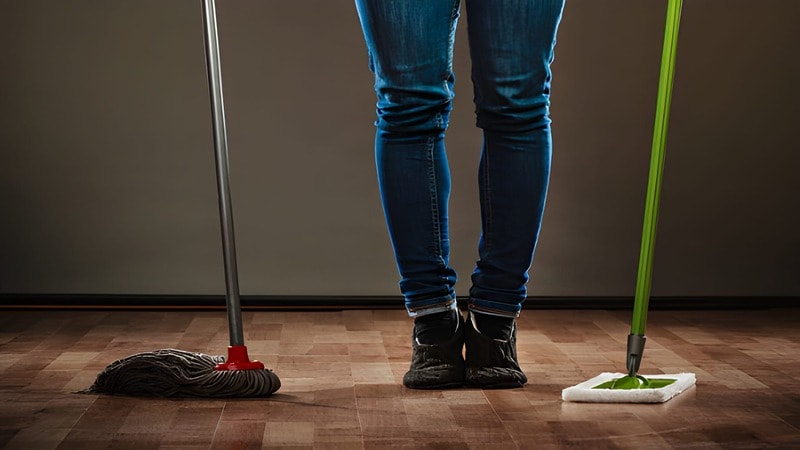Mopping a floor is part of routine, but do you actually know how to mop a floor according to your surface type?
Although mopping is an easy task; it’s not always as simple as mixing a cleaning solution in a bucket of water. For instance, laminate floors only need a damp mop, while tile floors can handle a little more water. A good cleaning expert also recommends sweeping or using a broom or vacuum before mopping. Each floor type needs a specific approach.
In this article, we will share how to mop a floor correctly for every floor type. We’ll also discuss proper mopping techniques for different surfaces. Let’s get started!
Know Your Floor Type Before You Start
Before you begin mopping, it’s essential to identify your floor type. Each floor surface reacts differently to water, cleaning products, and mop heads. Knowing your surface helps you choose the right mop, bucket, and solution to prevent damage and maintain its look.
Here’s a quick guide to help you understand which mop type and cleaning product work best for each surface:
| Floor Type | Mop Type | Cleaning Product |
|---|---|---|
| Vinyl Floors | Regular or sponge mop | Mild dish soap + water |
| Laminate Floors | Microfiber mop head | Gentle or laminate-safe cleaner |
| Hardwood Floors | Microfiber or sponge mop | Wood-safe cleaning solution |
| Stone / Marble Floors | Soft mop or rag mop | pH-neutral solution only |
| Concrete Floors | String mop or sponge mop | Mild detergent or dish soap |
Once you identify your floor type, it becomes easier to select the right tools and products for the job. You’ll also know how much water to use, how to wring the mop head, and when to dry completely to avoid damage.
Tools and Setup: What You’ll Need
Always take a moment to prepare your tools. A few simple tools can make a big difference between an average clean and a spotless floor.
1. Choose the Right Mop Head

Not every mop head works for all floor surfaces.
- Microfiber mops are best for laminate and hardwood floors. They absorb dirt well and use less water.
- Sponge mops are great for vinyl or tile floors, especially when tackling sticky spots.
- String mops cover larger areas and work well for concrete or garage floors.
- Flat mops are lightweight and ideal for daily cleaning in high traffic areas like kitchens and bathrooms.
2. Use Two Buckets
Use two buckets to make mopping easier and cleaner.
- Fill one bucket with water and cleaning product.
- The other bucket is for rinsing out the dirty mop head.
This keeps dirt and grime from spreading across the floor surface.
3. Pick the Right Cleaning Solution
Choose a cleaning product based on your floor type.
- Opt for wood-safe cleaners for hardwood floors
- Go for pH-neutral solutions for stone or marble
- Try mild dish soap for vinyl or laminate floors
Always read the manufacturer’s instructions before using any product. Using the wrong solution can cause residue, scratches, or warping.
4. Optional Cleaning Accessories
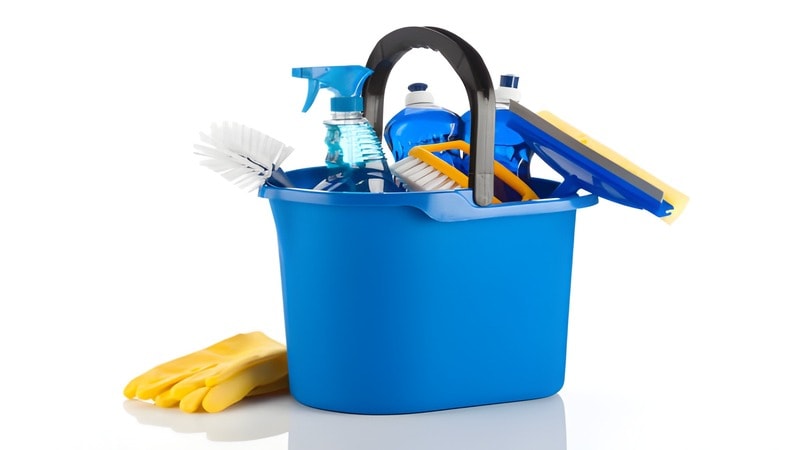
Adding a few extra items in your checklist can make the job easier:
- Keep a pair of gloves aside in order to protect your hands from harsh chemicals.
- Set aside few Microfiber cloths to cleanup different edges and corners in the room.
- Collect drying towels to dry the floor completely after mopping.
With these basic tools you can get the best results for every floor surface.
How to Mop Different Floor Types
Every floor has its own personality. What works for one might ruin another. That’s why it’s important to know a few simple tricks for each surface before you start mopping.
Hardwood Floors
Hardwood is beautiful but delicate. Excess water can make it swell or lose its shine. Avoid wet mop and try to use a damp microfiber mop. Moreover, move mop in straight lines along the wood grain. A few sprays of a wood-safe cleaner are enough. After mopping, go over it with a dry towel or cotton cloth to keep the shine and prevent water marks.
Laminate Floors
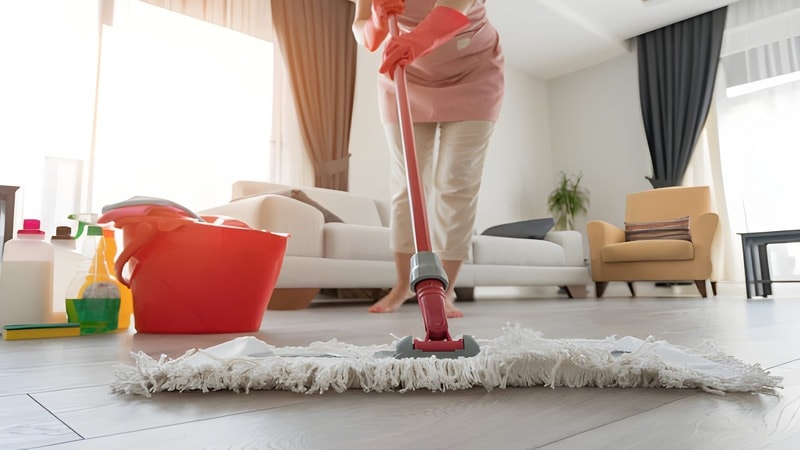
Laminate flooring and water are not good friends. Try to use a lightly wrung-out microfiber mop and move it in smooth “S” patterns to cover more area without rewetting. This technique also prevents streaking. Additionally for sticky spots, spray a bit of laminate-safe cleaner directly and wipe with a damp microfiber cloth before continuing.
Tile Floors
Tiles usually handle everything easily. Dip your sponge or string mop into warm soapy water, wring it out slightly, and move in back-and-forth strokes. Work in small sections, so dirt doesn’t dry before you rinse it off. Don’t forget to give extra attention to grout lines, using a brush if needed. Finish by rinsing with clean water and letting it air dry.
Vinyl Floors
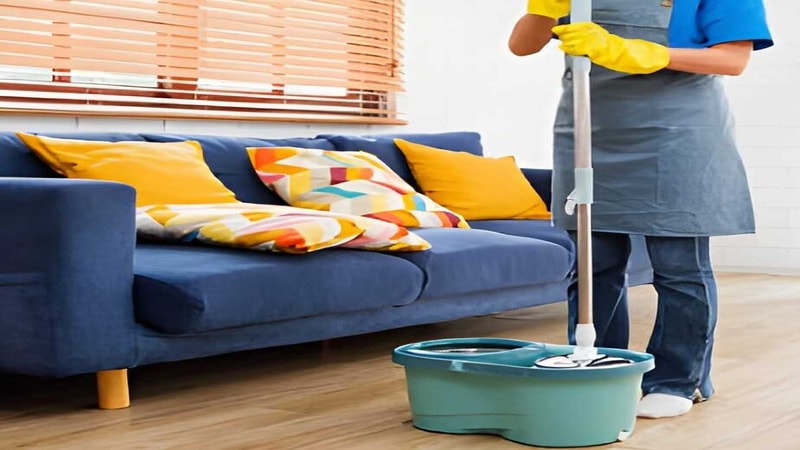
Vinyl floors are low maintenance but do best with a bit of technique. Use a soft mop and clean in gentle circular motions to lift grime without scratching the surface. Mix a few drops of dish soap with warm water. Avoid scrubbing too hard or using bleach or harsh chemicals—they can dull the finish over time.
Stone or Marble Floors
Stone floors deserve special care. Always use a pH-neutral cleaner and soft mop head. Move in large “S” patterns to evenly spread the cleaner without letting it sit too long. Never use vinegar or acidic products—they can leave dull patches. Once you’re done, dry the surface immediately with a soft towel to protect its natural shine.
Common Mopping Mistakes to Avoid
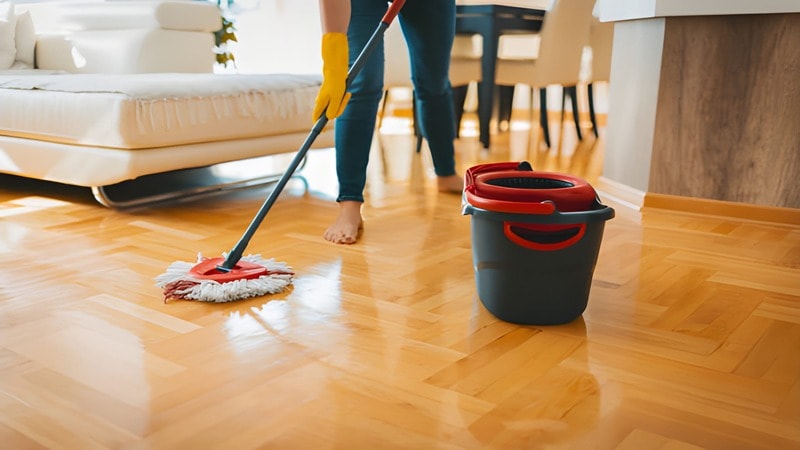
Do you know 2 hours of mopping can burn 200 calories, but unfortunately final goal is clean house. Even the best mop won’t give you clean floors if you use it the wrong way. A few small habits can leave behind streaks, debris, or even damage your floor surface. Here’s what to look out for:
- Using too much water can cause wood or laminate floors to warp. Always wring your mop so it’s damp, not dripping.
- Skipping the pre-clean step spreads dirt around. Sweep or vacuum first to remove dust, debris, and crumbs.
- Reusing dirty water only pushes grime back onto the floor. Change the water when it looks cloudy.
- Forgetting to clean the mop head spreads old dirt. Wash and dry it after every use and replace it when it looks worn.
- Using the same mop for every floor type can cause scratches. Match your mop head and cleaner to your floor surface.
Pro Tip: Treat your mop like any other cleaning tool. Store it upright, let it air dry, and make sure it’s ready for the next clean.
Conclusion
A spotless floor comes from knowing your surface, using the right mop head, and following proper mopping techniques. Whether it’s laminate, tile, vinyl, or hardwood, every floor needs its own care.
Work in small sections, rinse often, and let it dry completely. When you avoid common mistakes like using too much water or walking on wet floors, your floors stay clean, shiny, and damage-free for longer.
Keep Your Cleaning Simple with Manywell
At Manywell, we believe that clean spaces start with smart tools. Whether it’s choosing the right mop or cleaning accessories, our products are designed to make everyday cleaning easier and more effective. Get in touch with us and explore our range of cleaning tools.

